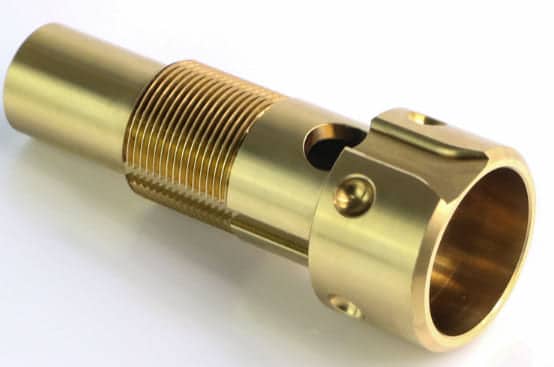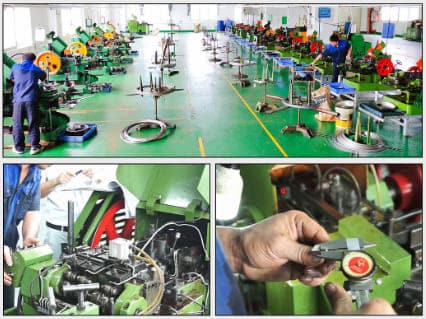Tapped and threaded holes are important parts of mechanical engineering and manufacturing that let you fasten components securely with screws, bolts, and other threaded fasteners.
Tapping and threading both have the same basic purpose, but there are a few key differences. You need to understand both to choose the right method for your application.
Yijin Hardware offers on-demand manufacturing services, and we want to share our expert knowledge to guide you through the process. Let’s weigh up tapping vs. threading, their applications, pros and cons, and more.
Key Takeaways
- Tapped holes are created using taps to form internal threads within a pre-drilled hole.
- Threaded holes can be made through a few different methods, including tapping, thread milling, or using threaded inserts.
- Tapped holes are usually faster and more affordable to produce than threaded holes.
- Choosing between tapped and threaded holes depends on factors like the application, material, and thread specifications.
- Understanding the differences between the two helps in selecting the right method for creating strong, reliable connections in various industries.
- Whether you’re a manufacturer looking for high-quality fasteners or an engineer designing a new product, a trusted bolts and nuts supplier can provide the necessary components for your project.
What are Tapped Holes?
A tapped hole is one kind of threaded hole or, more simply, a cylindrical hole. This hole is drilled and then processed with a tap to create internal threads. The drilling and tapping process lets you insert fasteners like screws or bolts that can safely fit into the internal threads of the hole.
Tapped holes can be either through holes or blind holes, but blind holes do not penetrate completely through the material. Taper taps are often used as starter taps for blind holes or through holes. Additionally, a bottoming tap is designed to cut threads all the way to the bottom of a blind hole.
Applications
Tapped holes are often used in:
- Machinery assembly, as they provide safe fastening points for components
- Automotive parts, where tapped holes are commonly used to make assembly and disassembly of car parts easier
- Furniture manufacturing, where a tapped hole is a type of threaded hole that creates strong connections between different materials

Pros
There are many benefits of using a tap hole:
- Quick Production: The process of tapping is usually faster than threading.
- Cost-Effective: Tapped holes need less machining time and fewer tools.
- Strong Thread Engagement: Tap holes provide reliable fastening capabilities.
Cons
Here are the cons of using a drilled hole that is tapped:
- Limited to Internal Threads: Tapping only creates internal threads, whereas external threading requires different processes.
- Tool Breakage Risk: Taps can break when you use them, which can complicate production.
- Material Limitations: Not all materials are suitable for tapping. Harder types of materials can wear out taps quickly.
What are Threaded Holes?
A threaded hole is essentially any hole that contains a number of threads. These holes can be created through a few different methods like tapping, thread milling, or using threaded inserts. This flexibility means that threads in a hole have more applications compared to tapped holes.
It’s important to understand the threads per inch (TPI) to make sure that bolts and screws fit properly into the clearance hole. If you use fasteners with mismatched TPI, it can lead to stripped threads or unsteady connections.
Applications
You can often find threaded holes in these applications:
- Piping Systems: You can create a threaded hole connection for sealing joints.
- Heavy Machinery: You can make threaded holes to provide strong anchor points for large components.
- Custom Parts Manufacturing: Threaded holes are also used for specialized thread profiles when they are needed.

Pros
Here are a few benefits of using threaded holes:
- Versatility in Threading Methods: The threading process can handle various thread types and thread sizes.
- Customizable: You can customize and cut threads for unique thread specifications outside of standard sizes.
- Higher Strength Potential: You can thread a hole designed for greater load-bearing capacity.
Cons
These are the disadvantages you might face when you create threaded holes:
- Longer Production Time: When you create threads in the hole, it can take more time, because it’s a complicated process.
- Higher Costs: Threaded parts might need specialized equipment, which can increase the price of manufacturing expenses. Threading costs will vary depending on the method, material, and precision required.
- Precision Issues: Achieving exact specifications for threads all the way might need more advanced machinery.
Tapped vs. Threaded Hole: Comparison
It’s time to weigh up tapped holes vs. threaded holes! Here are the main differences:
Type of Threads Created
Tapped holes specifically create internal threads using a tap as a cutting tool for the material. This method and type of hole are straightforward and efficient for creating standard screw threads.
On the other hand, threaded holes contain a broader range of thread types and sizes. This is because this class of thread can be produced through different methods like thread milling or using dies. This flexibility means you can select specific thread profiles based on application needs and create external threads.
Variety of Thread Options
When it comes to variety, a tap hole is limited to standard thread sizes and pitch diameters, which are decided based on the type of tap used. Moreover, threaded holes give you better customization.
By using different CNC machining techniques like thread milling or custom dies, manufacturers can create special threads customized for your application. These range from fine threads with high accuracy to coarse threads designed for fast assembly.
Risk of Tool Breakage
Tapped holes come with some big risks in terms of tool breakage. The tap must be aligned properly with the drilled bit and hole. If not, it can break during operation — especially if too much force is applied or if it comes into contact with hard materials.
Threaded hole creation processes like thread milling usually have a lower risk of tool breakage. This is because they use rotating cutting tools that remove material more slowly and evenly.
Hole Depth Considerations
Blind tapped holes do not go completely through the material. This can limit their applications where full penetration is needed.
On the other hand, threaded holes can be designed as either blind or through holes, based on your needs. Being able to create both types means threaded holes have more flexibility in applications.
Material Compatibility
Material limitations play an important role when choosing between threaded vs. tapped holes. Tapping is typically limited by material hardness. Harder materials like titanium might cause taps to wear out quickly or break when you use them.
Threaded hole techniques give you more options when working with difficult materials. This is because they allow for different cutting strategies that might work better for tougher substrates.
Yijin Hardware: High Quality Machined Components
Both tapped and threaded holes are efficient techniques in machining and assembly processes. So, it’s important to weigh up your project’s needs, budget, and risks of both options when you make your choice.
Yijin Hardware specializes in producing high-quality machined components that meet all your specific requirements. Whether you need tapped or threaded holes for your custom parts, we’re ready to help bring your vision to life. Contact us for a quote!
Tapped and Threaded FAQs
What does tap the threads mean?
Tapping the thread is the process of cutting or creating threads using a tap. When you do this process with a die instead, it is known as threading.
How do you tap threads properly?
To tap threads properly, you must drill a hole diameter with the right bolt size, and then begin tapping by rotating the tap bit clockwise until you feel resistance. For each rotation clockwise, you’re going to want to make half of a rotation counterclockwise. After you finish tapping, you must take the tap out and clean the chips from the tap and the material.
Can I use a tap to clean or repair damage to existing threaded holes?
Yes, you can use a tap to clean or repair damage to existing threaded holes. However, repairing damage to threaded holes with taps usually only works if there is minimal damage. For severe damage, you may need to use a thread insert instead.
Back to Top: Tapped and Threaded

 info@yijinsolution.com
info@yijinsolution.com (+86) 188-2253-7569
(+86) 188-2253-7569







